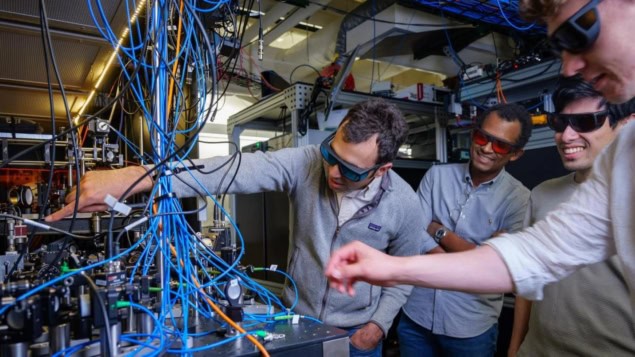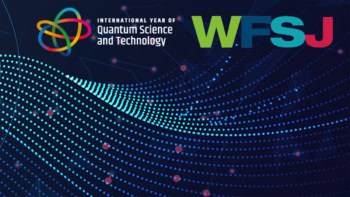
Frequency measurements using multi-qubit entangled states have been performed by two independent groups in the US. These entangled states have correlated errors, resulting in measurement precisions better than the standard quantum limit. One team is based in Colorado and it measured the frequency of an atomic clock with greater precision than possible using conventional methods. The other group is in California and it showed how entangled states could be used in quantum sensing.
Atomic clocks are the most accurate timekeeping devices we have. They work by locking an ultraprecise, frequency comb laser to a narrow linewidth transition in an atom. The higher the transition’s frequency, the faster the clock ticks and the more precisely it can keep time. The clock with the best precision today is operated by Jun Ye’s group at JILA in Boulder, Colorado and colleagues. After running for the age of the universe, this clock would only be wrong by 0.01 s.
The conventional way of improving precision is to use higher-energy, narrower transitions such as those found in highly charged ions and nuclei. These pose formidable challenges, however, both in locating the transitions and in producing stable high-frequency lasers to excite them.
Standard quantum limit
An alternative is to operate existing clocks in more sophisticated ways. “In an optical atomic clock, you’re comparing the oscillations of an atomic superposition with the frequency of a laser,” explains JILA’s Adam Kaufman, “At the end of the experiment, that atom can only be in the excited state or in the ground state, so to get an estimate of the relative frequencies you need to sample that atom many times, and the precision goes like one over the square root of the number of samples.” This is the standard quantum limit, and is derived from the assumption that the atoms collapse randomly, producing random noise in the frequency estimate.
If, however, multiple atoms are placed into a Greenberger–Horne–Zeilinger (GHZ) entangled state and measured simultaneously, information can be acquired at a higher frequency without increasing the fundamental frequency of the transition. JILA’s Alec Cao explains, “Two atoms in a GHZ state are not just two independent atoms. Both the atoms are in the zero state, so the state has an energy of zero, or both the atoms are in the upper state so it has an energy of two. And as you scale the size of the system the energy difference increases.”
Unfortunately the lifetime of a GHZ state is inversely proportional to its size. Therefore, though precision can be acquired in a shorter time, the time window for measurement also drops, cancelling out the benefit. Mark Saffman of the University of Wisconsin-Madison explains, “This idea was suggested about 20 years ago that you could get around this by creating GHZ states of different sizes, and using the smallest GHZ state to measure the least significant bit of your measurement, and as you go to larger and larger GHZ states you’re adding more significant bits to your measurement result.”
In the Colorado experiment, Kaufman, Cao and colleagues used a novel, multi-qubit entangling technique to create GHZ states of Rydberg atoms in a programmable optical tweezer lattice. A Rydberg atom is an atom with one or more electrons in a highly-excited state. They showed that, when interrogated for short times, four-atom GHZ states achieved higher precisions than could be achieved with the same number of uncorrelated atoms. They also constructed gates of up to eight qubits. However, owing to their short lifetimes, they were unable to beat the standard quantum limit with these.
Cascade of GHZ qubits
The Colorado team therefore constructed a cascade of GHZ qubits of increasing sizes, with the largest containing eight atoms. They showed that the fidelity achieved by the cascade was superior to the fidelity achieved by a single large GHZ qubit. Cao compares this to using the large GHZ state on a clock as the second hand while progressively smaller states act as the minute and hour hands. The team did not demonstrate higher phase sensitivity than could theoretically be achieved with the same number of unentangled atoms, but Cao says this is simply a technical challenge.

Nuclear clock ticks ever closer
Meanwhile in California, Manuel Endres and colleagues at Caltech also used GHZ states to do precision spectroscopy on the frequency of an atomic clock using Rydberg atoms in an optical tweezer array. They used a slightly different technique for preparing the GHZ states. This did not allow them to prepare such large GHZ states as their Coloradan counterparts, although Endres argues that their technique should be more scalable. The Caltech work, however, focused on mapping the output data onto “ancilla” qubits and demonstrating a universal set of quantum logic operations.
“The question is, ‘How can a quantum computer help you for a sensor?’” says Endres. “If you had a universal quantum computer that somehow produced a GHZ state on your sensor you could improve the sensing capabilities. The other thing is to take the signal from a quantum computer and do quantum post-processing on that signal. The vision in our [work] is to have a quantum computer integrated with a sensor.”
Saffman, who was not involved with either group, praises the work of both teams. He congratulates the Coloradans for setting out to build a better clock and succeeding – and praises the Californians for going in “another direction” with their GHZ states. Saffman says he would like to see the researchers produce larger GHZ states and show that such states can not only confer an improvement on a clock with the same limitations as a similar clock measured with random atoms, but can produce the world’s best clock overall.
The research is described in two papers in nature Nature (California paper, Colorado paper).



